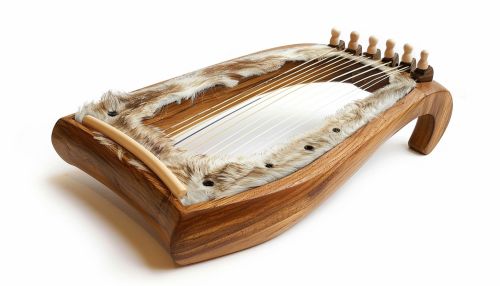Kissar
Introduction
The kissar, also spelled kissir, is a traditional stringed musical instrument originating from the Nubian region of Sudan and Egypt. It is a type of lyre, a class of string instruments known for their U-shaped frame and strings that run parallel to the soundboard. The kissar has a rich cultural history and has been used in various ceremonial and social contexts. This article delves into the construction, history, cultural significance, and playing techniques of the kissar.
Historical Background
The kissar has ancient roots, with evidence suggesting its use dating back to the Pharaonic period in Egypt. It is believed to have evolved from earlier lyres depicted in ancient Egyptian art and artifacts. The instrument was traditionally used in religious ceremonies, particularly in the worship of the god Amun. Over time, the kissar spread to different regions, including Nubia and Ethiopia, where it became an integral part of local musical traditions.
Construction and Design
The kissar is typically made from a wooden frame, often carved from a single piece of wood. The frame is U-shaped, with two arms extending upwards from the base. A soundboard, usually made from animal hide, is stretched across the base of the frame. The strings, traditionally made from gut, are attached to a crossbar that spans the top of the frame. The number of strings can vary, but most kissars have between five and seven strings.


The tuning of the kissar is achieved by adjusting the tension of the strings using tuning pegs located at the top of the frame. The instrument is often decorated with intricate carvings and sometimes inlaid with mother-of-pearl or other materials.
Playing Techniques
The kissar is played by plucking the strings with the fingers or a plectrum. The musician typically holds the instrument upright, with the soundboard facing outward. The strings are plucked in a manner similar to that of a harp, producing a resonant and melodic sound. In some traditions, the kissar is played in accompaniment with singing or other instruments, such as drums or flutes.
Cultural Significance
The kissar holds a significant place in the cultural heritage of the Nubian and Ethiopian people. It is often used in religious ceremonies, weddings, and other social gatherings. The instrument is also associated with storytelling and oral traditions, where it accompanies the recitation of epic tales and poetry.
In Nubian culture, the kissar is considered a symbol of identity and pride. It is often played during festivals and community events, serving as a means of preserving and transmitting cultural knowledge. The instrument is also used in healing rituals, where its music is believed to have therapeutic properties.
Modern Usage and Revival
In recent years, there has been a resurgence of interest in traditional musical instruments, including the kissar. Efforts to revive and preserve the instrument have led to its inclusion in contemporary music and cultural projects. Musicians and ethnomusicologists are working to document and promote the kissar, ensuring that its unique sound and cultural significance are not lost to future generations.
